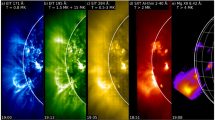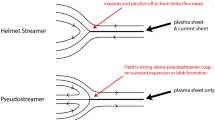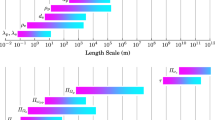Abstract
Results of the analysis of spacecraft measurements at 1–5.4 AU are presented within the scope of the large-scale interplanetary magnetic field (IMF) structure investigation. The work is focused on revealing of the radial IMF component (B r ) variations with heliocentric distance and latitude as seen by Ulysses. It was found out that |B r | decreases as ∼r −5/3 in the ecliptic plane vicinity (±10° of latitude), which is consistent with the previous results obtained on the basis of the analysis of in-ecliptic measurements from five spacecraft. The difference between the experimentally found (r −5/3) and commonly used (r −2) radial dependence of B r may lead to mistakes in the IMF recalculations from point to point in the heliosphere. This can be one of the main sources of the “magnetic flux excess” effect, which is exceeding of the distantly measured magnetic flux over the values obtained through the measurements at the Earth orbit. It is shown that the radial IMF component can be considered as independent of heliolatitude in a rough approximation only. More detailed analysis demonstrates an expressed |B r | (as well as the IMF strength) increase in the latitudinal vicinity of ±30° relative to the ecliptic plane. Also, a slight increase of the both parameters is observed in the polar solar wind. The comparison of the B r distributions confirms that, at the same radial distance, B r values are higher at low than at high latitudes. The analysis of the latitudinal and radial dependences of the B r distribution’s bimodality is performed. The B r bimodality is more expressed at high than in the low-latitude solar wind, and it is observed at greater radial distances at high latitudes. The investigation has not revealed any dependence between B r and the solar wind speed V. The two-peak distribution of the solar wind speed as measured by Ulysses is a consequence of a strong latitudinal and solar cycle dependence of V. It is shown that the solar wind speed in high latitudes (above ±40°) anti-correlates with a solar activity: V is maximum during solar-cycle minima and minimum at the maximum of solar activity.
Similar content being viewed by others
References
R. L. Rosenberg, J. Geophys. Res.: Space Phys. 75, 5310 (1970).
A. V. Belov, V. N. Obridko, and B. D. Shelting, Geomagn. Aeron. 46, 430 (2006).
E. J. Smith, J. Geophys. Res.: Space Phys. 118, 58 (2013); doi:10.1002/jgra.50098.
M. M. Echim, J. Lemaire, and O. Lie-Svendsen, Surv. Geophys. 32, 1 (2011).
V. N. Obridko, A. F. Kharshiladze, and B. D. Shelting, Astron. Astrophys. Trans. 11, 65 (1996).
P. Riley, Astrophys. J. Lett. 667, L97 (2007); doi:10.1086/522001.
M. J. Owens, H. E. Spence, S. McGregor, et al., Space Weather 6, S08001 (2008); doi:10.1029/2007SW000380.
M. J. Owens, C. N. Arge, N. U. Crooker, et al., J. Geophys. Res. 113, A12103 (2008); doi:10.1029/2008JA013677.
M. Lockwood, M. Owens, and A. P. Rouillard, J. Geophys. Res. 114, A11104 (2009); doi:10.1029/2009JA014450.
E. J. Smith, J. Geophys. Res.: Space Phys. 116, A12 (2011); doi:10.1029/2011JA016521.
M. Lockwood and M. Owens, J. Geoph. Res.: Space Phys. 118, 5 (2013); doi:10.1002/jgra.50223 (2013).
M. Lockwood and M. Owens, Astrophys. J. 701, 964 (2009); doi:10.1088/0004-637X/701/2/964.
O. Khabarova and V. Obridko, Astrophys. J. 761, 82 (2012); doi:10.1088/0004-637X/761/2/82.
P. Riley, J. A. Linker, and Z. Mikic, J. Geophys. Res. 107, A7 (2002); doi:10.1029/2001ja000299.
N. A. Schwadron and D. J. McComas, Geophys. Res. Lett. 32, L03112 (2005); doi:10.1029/2004GL021579.
K. Mursula and I. I. Virtanen, J.Geophys.Res. (2013, in press); doi:10.1029/2011JA017197.
C. M. Ho, B. T. Tsurutani, J. K. Arballo, et al., Geophys. Res. Lett. 24, 915 (1997); doi:10.1029/97GL00806.
M. Neugebauer, R. J. Forsyth, A. B. Galvin, et al., J. Geophys. Res. 103, 14587 (1998); doi:10.1029/98JA00798.
X. P. Zhao, J. T. Hoeksema, Y. Liu, and P. H. Scherrer, J. Geophys. Res. 111, A10108 (2006); doi:10.1029/2005JA011576.
M. Lockwood, R. B. Forsyth, A. Balogh, and D. J. McComas, Ann. Geophys. 22, 1395 (2004).
E. J. Smith, A. Balogh, R. F. Forsyth, et al., Adv. Space Res. 26, 823 (2000); doi:10.1016/S0273-1177(00)00014-4.
A. Balogh, E. J. Smith, B. T. Tsurutani, et al., Science 268, 1007 (1995); doi:10.1126/science.268.5213.1007.
G. Erdős and A. Balogh, Astrophys. J. 753, 130 (2012); doi:10.1088/0004-637X/753/2/130.
K. M. Kuzanyan and D. D. Sokoloff, Geophys. Astrophys. Fluid Dyn. 81, 113 (1995); doi:10.1080/03091929508229073.
A. B. Asgarov and V. N. Obridko, Sun Geosphere 2, 29 (2007).
O. Khabarova and V. Obridko, Preprint Inst. Terrestr. Magn. (IZMIRAN, Troitsk, Moscow, 2011). http://arxiv.org/ftp/arxiv/papers/1102/1102.1176.pdf
V. N. Obridko, E. V. Ivanov, A. Özgüç, et al., Solar Phys. 281, 779 (2013).
Yu. I. Ermolaev, N. S. Nikolaeva, I. G. Lodkina, and M. Yu. Ermolaev, Kosmich. Issled. 47, 1 (2009).
I. S. Veselovskii and A. T. Lukashenko, Solar Syst. Res. 46, 149 (2012).
A. V. Usmanov, W. H. Matthaeus, B. A. Breech, and M. L. Goldstein, Astrophys. J. 727, 84 (2011); doi:10.1088/0004-637X/727/2/84.
D. F. Webb, T. A. Howard, C. D. Fry, et al., Solar Phys. 256, 239 (2009); doi: 10.1007/s11307-009-9351-8.
A. V. Usmanov, M. L. Goldstein, and W. H. Matthaeus, Astrophys. J. 754, 40 (2013); doi:10.1088/0004-637X/754/1/40.
Author information
Authors and Affiliations
Corresponding author
Additional information
Original Russian Text © O.V. Khabarova, 2013, published in Astronomicheskii Zhurnal, 2013, Vol. 90, No. 11, pp. 919–935.
Rights and permissions
About this article
Cite this article
Khabarova, O.V. The interplanetary magnetic field: Radial and latitudinal dependences. Astron. Rep. 57, 844–859 (2013). https://doi.org/10.1134/S1063772913110024
Received:
Accepted:
Published:
Issue Date:
DOI: https://doi.org/10.1134/S1063772913110024




